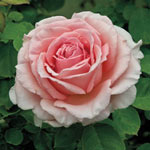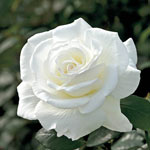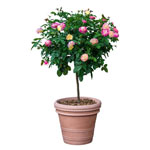Roses

Rose Varieties Available at Breck's
Breck's offers rose bush varieties of grandiflora roses, floribunda roses, hybrid tea roses, shrub roses and climbing roses. Each of these varieties offer their own unique take on the romantic rose: and, you'll be surprised to find out just how easy it is to grow roses.Grandiflora, floribunda, and hybrid tea roses are all varieties of cane roses -- what we think of when we talk about "long stemmed roses." Hybrid teas are the oldest of the modern rose varieties, and some of these beautiful species have been around since the late 1800s. Hybrid tea roses have an upright, straight-laced growth habit, and can grow from three to seven feet tall, with a width of three or four feet. Hybrid teas feature single blooms on long stems, and are known for their classic, "rosey" scent.
Floribunda roses tend to grow out as well as up, and grow a few feet tall and three to five feet wide. These beauties are easier to grow, but still bloom in an amazing array of colours and patterns. While hybrid teas can be picky about their sun exposure, Floribundas tend not to mind full sun. Floribundas don't always feature the same sweet scent as hybrid teas, but they make up for it with ever-blooming flowers: and they grow multiple flowers per stem!
Grandiflora roses are a cross between Floribunda and hybrid tea roses. These are the hardiest of the hardy roses -- they thrive nearly anywhere. Grandifloras have large blooms clustered on long stems, making them perfect for picturesque bouquets. Most Grandiflora roses feature double-blooming flowers, and, much like their Floribunda roses, they bloom all season long.
Shrub roses are just what they sound like: rose bushes! Shrub roses have a dense growing habit and glossy leaves as well as gorgeous flowers. Shrub roses can be used for privacy hedging, as a highlight among smaller flowers in the garden, or as a way to line a walkway or sidewalk. Shrub roses are known for their bright, round rosehips, which add interest to winter gardens and can also be used in bouquets.
Climbing roses are amazing space fillers: especially the modern, jumbo varieties available from Breck's. Climbing roses grow over arches, trellises or arbors to create a real-life backdrop of flowers. Climbers tend to thrive in partial shade, but many varieties can handle a good amount of sun.
Why Should You Buy Rose Plants or Bushes From Breck's?
A new rose plant will provide stunning color, fragrance and texture in just about any garden setting. No matter which variety of rose you choose, you'll be glad to choose roses from Breck's! Our premium rose bushes, climbing roses, Floribundas, Grandifloras and classic hybrid teas are the brightest -- and newest! -- varieties.Breck's has a wider variety of bare root roses for sale than most online outlets, and we ship directly from the greenhouse to your door. Our careful packaging, along with the varieties we've carefully-selected for success in North American gardens, ensure you the best chance at successful growing.
Gardener's guide to roses
What to do After Receiving Your Rose Bush
Most roses from Breck's ship as bare root plants. When you receive your rose plant from Breck's, unwrap the plant and soak the roots in a pail of water for at least an hour, but no longer than overnight. Soaking the roots gets them ready for planting.How to Plant Roses
Want to learn how to plant a rose? Select a sunny location, receiving at least six hours of sun each day, and make sure your intended locale has well drained soil. Roses do not like "wet feet." By choosing the right location for your rose plant, you can help it put its best shoots forward!Although your roses can be planted at any time, best results are achieved when they are planted on a cloudy, calm day. Dig a hole 12 to 12 inches deep, wide enough so all of the roots can be spread out without touching the sides of the hole. Mix the soil from the hole with a good measure of leaf mold, peat moss, manure or compost. Then, mound a cone of soil in the centre of the hole. Trim off any broken roots, then spread healthy roots around the soil mound. Place the bud union (the knot at the base of the plant) at ground level for if you're gardening in a mild climate. If you're in a cold climate, place the bud union two or three inches.
Fill around the roots with your soil mixture. Once the hole is half full with soil mixture, water in the rose to settle soil and eliminate air pockets. Let water drain, and watch the water drain to make sure that your rose will have adequate drainage. Fill the remainder of the hole with your soil mixture, then water thoroughly again. Finally, mound loose soil up and around the rose canes to protect the plant from sudden temperature changes. After the rose is well-sprouted, you can wash away the piled-up soil.
How to Care For a Rose Bush or Rose Plant
A rose by any other name is just as sweet -- but how to grow a rose? Roses have a reputation for being finicky growers. But, unlike roses of old, today's modern roses require surprisingly little care. By following just a few basic tips, your rose will thrive and beautify for years.First, make sure to care for roses by choosing a good planting location: one that provides the sunlight, soil, and space your roses need to thrive! Then, provide just a little upkeep throughout the year.
Roses require the equivalent of 1 inch of rainfall each week. They will bloom best if their roots are kept moist but not waterlogged. Water thoroughly and weekly. A slow, deep soak at the ground is most efficient. Don't water from above, as wet foliage can attract disease.
You'll want to deadhead your roses throughout the season, especially if they are every-blooming varieties. Deadheading, the process of removing faded blooms from your rose plants, is the best way to keep hybrid tea, grandiflora and floribunda roses blooming all season. When you deadhead, cut back below the first five-leaflet stem to promote strong return growth. Removing any dead flowers prevents the formation of hips, so plants can direct their energy to developing new blooms and foliage. Most shrub roses we offer are self-cleaning. The petals drop on their own as they mature, and new blooms come behind them.
You'll need to winterize your roses if you live in Zone 5 or below. After the first killing frost of fall, make a mound of loose soil at least eight inches high over the base of the plant. Then cover the mound and remaining exposed canes with hay, straw, grass clippings, oak leaves or similar material.
Modern roses should be pruned early in the spring, when about half of the growth buds swell. First, remove any dead or damaged canes. If you want to keep your roses to the same size as previous years, cut no more than one-third of the plant back. Then, remove any crossing canes. Finally, you will want to remove any suckers -- those small shoots that come up from the ground and don't produce blooms.



















